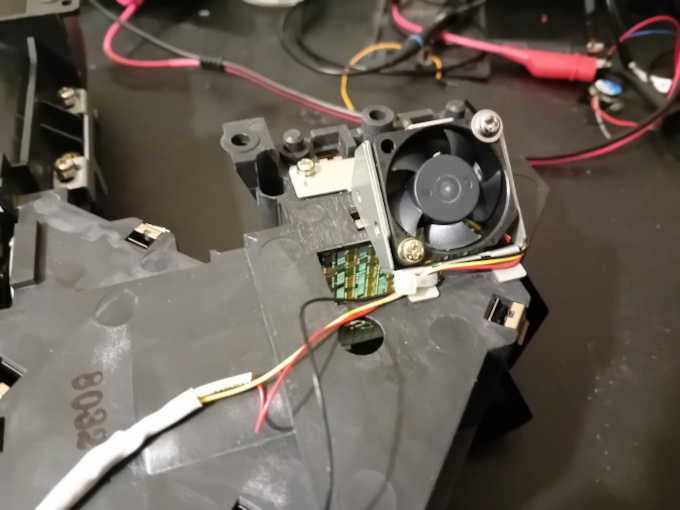What it's about
Replacement of a small fan in a video projector with adaptations of the new fan to the needs of the video projector's control logic. Video projector is a Sony VPL-S600. If you happen to have the same problem and want to fix it, I advise you to search the www for the excellent service manual.
Repair
Diagnosis
I became aware of the problem by a screeching sound which I suspected to be a dying fan. Finding the culprit, though, proofed to be less easy than anticipated. One of the projector's fans can be accessed via the air filter cover on the bottom of the projector. The one in the front of the projector can only be accessed by removing the front panel, in order for which the top cover first has to be removed.
These two fans made a good impression. Supplying the front fan with 12V did eliminate this fan. The connector of the fan in the bottom can be found below the optical unit (optical bench with lens, LCDs, condenser, polarizer plates and so on). Thus I removed the optical unit (remove the lamp first, as this will make removal of the optical unit way easier). The bottom fan also spun with normal sound when supplied with 12V. However then I found a third fan, attached to the optical unit's bottom. This one proofed to be the dying one.
Replacement of the dying fan
| Manufacturer | Shicoh |
|---|---|
| Model | IC FAN S0310-12 |
| Voltage | 12V |
| Current consumption | 0.095A |
| Dimensions | 30mm X 30mm X 10mm |
| Connection | 3-Wire |
I thus ordered a new fan with similar data, installed it, assembled everything back again and started the projector. Unfortunately I was greeted with a blinking yellow "TEMP/FAN" LED, indicating that the projector's control logic didn't think well of the new fan.
I immediately suspected the fan's tachometer signal to be the problem. After some research I found that there are 3-wire fans which generate a certain number of pulses per revolution. Yet others fans only apply a high level to the 3rd wire, when the fan is blocked. So I hooked up my oscilloscope to the original fan and found that it generates two pulses per revolution. I thus ordered another fan, which does the same.
When the second fan arrived, I hooked it up to my scope and, to my utter disappointment, had to find that it didn't generate any pulses. I already expected it to be broken, until I stumbled over a pull up resistor in a block diagram in the documentation of the fan's manufacturer. Said pull up resistor was drawn in a block titled "user system". And indeed, after I added a 10k pull up to the 12V line, I finally got pulses.
After this I found that the fan which I had ordered as first replacement also needs an external pull up in order to generate the pulses. So the original fan is rather special, as it generates the pulses without an external pull up. The pull up makes sense though, as the user system can define the high level of the pulses with this pull up. With the original fan the user system has to be able to deal with 12V pulses.
As the resistance between the original fan's tachometer output and the 12V input measured 300-something kΩ, I used a 470kΩ resistor in the end. I simply soldered the resistor into the wiring of the fan, as I had to connect the old cable with the cables of the new fan anyways. I used heat-shrink tubing for insulation. I also tightened the clamps of the metal housing, to which the fan is screwed, as I found them to be rather loose, and I suspect that the resulting vibrations might shorten the fan's lifespan.
After reassembly of the projector it ran again. Further info: the fan is mounted such that it blows into the optical unit. With the final fan I had to change the cable routing a bit, and fixated the cables with a zip tie to the metal holder of the fan, as can be seen in the image below.
| 1st fan | Final fan | |
|---|---|---|
| Manufacturer | Spire | Sunon |
| Model | SP03010S1M3 | MF30101V1-G99 |
| Current consumption | 0.1A | 0.055A |
